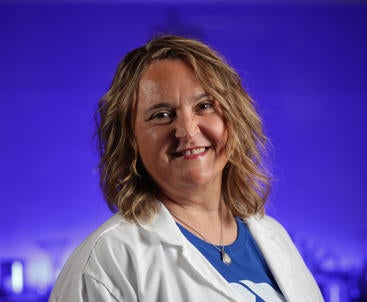Is It Feasible To Remove Carbon Dioxide From The Atmosphere?
A UC Riverside engineer discusses direct air capture
Last week, the media reported that atmospheric carbon dioxide is at its highest levels in more than 4 million years. Carbon dioxide in the atmosphere is one of the primary drivers of global warming. The dip in greenhouse gases associated with reduced travel during the pandemic was a fleeting blip in the larger trend of anthropogenic climate change—climate change driven by human activities. One reason for this is certain industries, which continued to emit greenhouse gases.
 Mihri Ozkan
Mihri Ozkan
A technology called “direct air capture” can literally suck carbon dioxide out of the air. Mihri Ozkan, a UC Riverside professor of electrical and computer engineering, recently published a commentary on direct air capture. She is the lead organizer for the EN13 -Climate Change and Mitigation Technologies Symposium that will focus on direct air capture technologies later this fall. Here, Professor Ozkan answers some questions about the feasibility of direct air capture.
Q: Why is industrial carbon dioxide, or CO2, difficult to eliminate?
A: According to the Mauna Loa Observatory in Hawaii, atmospheric CO2 levels today have increased to an average of nearly 420 parts per million. That is 50% higher than before the Industrial Revolution, when levels were at 280 ppm. Unfortunately, nearly 1.9 billion tons of industry CO2 emissions each year cannot be avoided using more feasible production technologies. Industrial processes with significant CO2 emissions that are difficult to avoid are cement making, natural gas processing, the production of iron, steel, ammonia/urea and biofuel, and various petrochemical processes that produce chemicals, plastics, and fibers.
Q: You’ve recently published on the feasibility of direct air capture of carbon dioxide to remove it from the atmosphere. Can you summarize how these technologies work?
A: Direct air capture, or DAC, of CO2 can help to deal with difficult-to-avoid emissions such as the ones I have mentioned above. In simple terms, DAC uses liquid or solid sorbents to capture CO2 directly from the atmosphere. Air first enters from the inlets and passes through the contactors, where CO2 is captured. Later, captured CO2 is released for permanent storage or reuse in different industrial applications.
Q: What are the potential environmental and financial costs, as well as the benefits of direct air capture?
A: Capital costs for equipment and commercialization costs are main considerations for DAC plants. For the liquid solvent-based systems, the majority of the capital expenses are contactor arrays for separating gases, oxy-fired calciner—a type of furnace used to remove CO2 from solid materials— slaker, causticizer, clarifier and condenser units. For the solid sorbent-based system, about 80% of the capital is associated with nitrogen functionalized porous materials, and the remaining is associated with the oxy-fired calciner, vacuum pump, and heat exchanger.
Liquid solvent-based systems cost slightly more to operate than the solid sorbent-based systems. This is mainly due to high energy demands when the sorbent or solvent is heated to remove the CO2 and ready it for reuse, along with the electricity required to run the fans.
Land and water consumption are further considerations for DAC. For a modern liquid solvent DAC technology to capture 1 ton of CO2, the system uses nearly 1–7 tons of water. In addition, a modern DAC plant powered geothermally and with 1 metric ton per year capture capacity requires a land area between 0.2–0.6 square kilometers (or about .1 to .4 square miles). While DAC does not require arable land, the size of land required can change based on the type of energy powering system used in operations.
Q: Is direct air capture a good option to rapidly decarbonize industry?
A: At this time, with the current status of DAC technology, it can help to compensate emissions from sectors that are hard to decarbonize. To meet global goals—removal of 1,000 gigatons CO2 by 2100— using DAC alone, nearly 13,000 DAC plants with 1 metric ton CO2 per year capacity are needed today. We’d need a nearly $1.7 trillion capital investment globally. For that reason, other negative emission technologies need to be considered where they are more affordable and effective.
Q: What are some actions governments and industries should take in order to reduce greenhouse gas emissions?
A: Private investor, government, and company investments can help to cover the high capital cost of the DAC projects and can also help to scale up existing capture capacity of plants. Now, there are new initiatives from all around the world from the governments. In the USA, the 45Q tax credit program encourages companies to go green. To prevent climate crises, we need to decarbonize all sectors. Governments around the world need to bring policies to move in this direction, especially the ones that are highly industrialized.
Q: Your research seeks to develop sustainable energy storage and sources, often using recycled or harmless materials, like sand, mushrooms, and plastic bottles. What are you working on right now?
A: My research focuses on electrification of transportation; hence we focus on developing game changer ideas in the making of lithium-ion batteries. The total number of electric vehicles in 2030 is expected to be nearly 10 times more than today. A “Battery Rush” has started! Our research group investigates the ways to make lithium-ion batteries more sustainable by using natural, renewable sources and waste materials such as plastics and glass. We also focus on new solid-state and unconventional batteries.
Publication: Mihrimah Ozkan, et al., Direct air capture of CO2:A response to meet the globalclimate targets, MRS Energy & Sustainability (2023). DOI: 10.1557/s43581-021-00005-9
Original Story Source: University of California – Riverside

 Alerts Sign-up
Alerts Sign-up